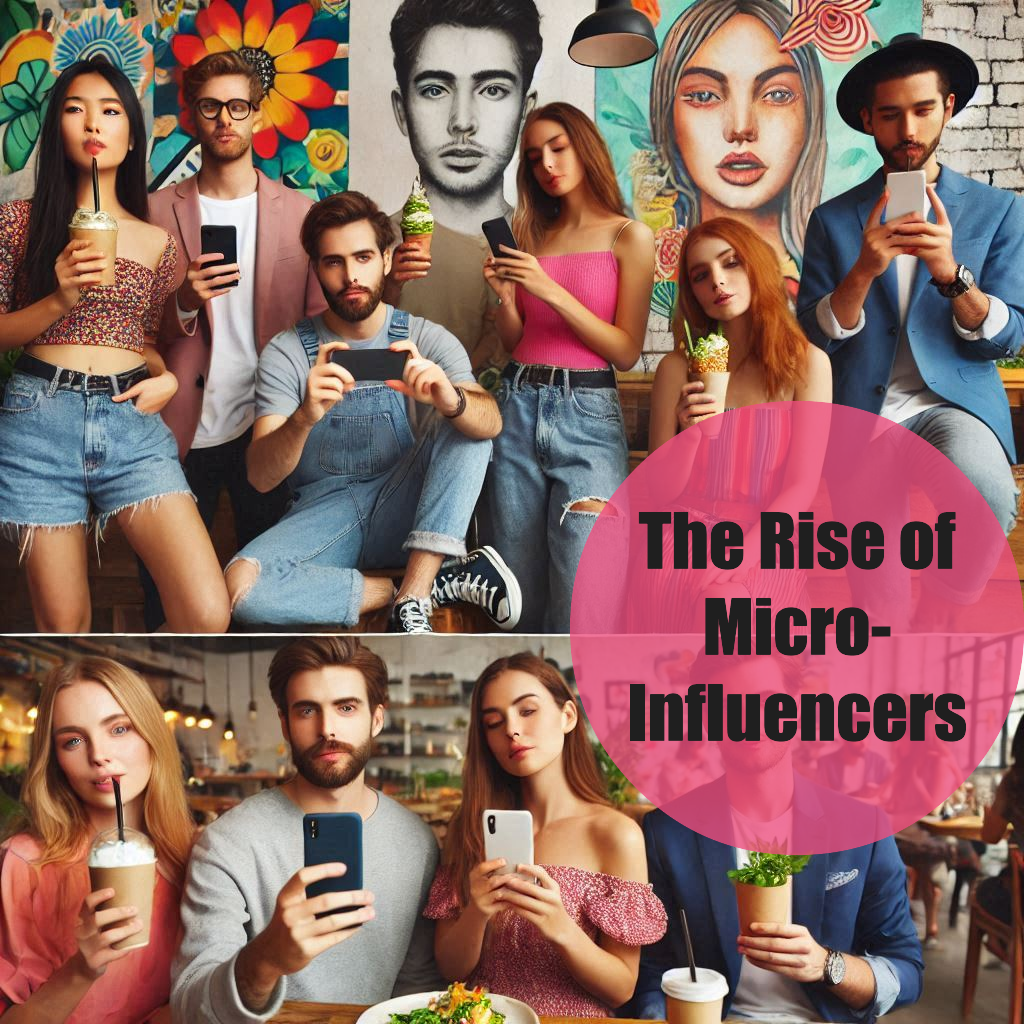Last Updated on December 5, 2024 by Val Razo
In today’s ever-evolving landscape of digital marketing, the focus is shifting from large-scale celebrity endorsements to the genuine appeal of micro-influencers. These individuals, who typically boast a smaller follower count than traditional influencers, are carving a niche by fostering authentic connections with their audience. Dubbed Micro-Influencers 2.0, these content creators excel at engagement, delivering more impactful results in influencer marketing campaigns.
Brands are increasingly realizing the value of partnering with micro-influencers who resonate with specific target audiences. Not only do they offer better ROI, but their approach also ensures meaningful collaboration that avoids the pitfalls of one-off sponsorships. Whether you’re exploring influencer marketing trends or seeking guidance on how to find the right micro-influencers, this article provides actionable insights into building trust, measuring success, and leveraging social media platforms for effective campaigns.

The Rise of Micro-Influencers in Modern Marketing
What Defines Micro-Influencers and Their Role in Influencer Marketing 2.0
Micro-influencers are reshaping the landscape of influencer marketing with their smaller yet highly engaged audiences. Typically, they have a follower count ranging from 1,000 to 100,000 and specialize in creating content for niche markets. Unlike traditional influencers, their success isn’t measured solely by reach but by their ability to drive meaningful interactions. This evolution, referred to as Influencer Marketing 2.0, prioritizes genuine relationships over large-scale visibility.
Micro-influencers play a critical role in modern marketing strategies by combining relatability with expertise. Their audience sees them as authentic individuals who genuinely use and endorse the products they promote. This authenticity fosters trust, making their recommendations more impactful for brands aiming to connect with a targeted demographic.
Micro-Influencers vs. Celebrity Influencers: Which Is Better for ROI?
When it comes to measuring ROI in influencer marketing campaigns, micro-influencers often outperform their celebrity counterparts. While celebrity influencers can reach millions, their campaigns often come across as impersonal and transactional. In contrast, micro-influencers boast higher engagement rates, with their followers actively interacting with their content.
For brands, this translates to more actionable outcomes—higher click-through rates, increased conversions, and stronger brand loyalty. Moreover, micro-influencers tend to charge less for collaborations, making them a cost-effective solution for businesses looking to maximize their marketing budget. The ability to tap into niche markets with authentic connections further solidifies their value in driving a better return on investment.
Fashion brands like Daniel Wellington have leveraged micro-influencers by gifting products in exchange for content. These influencers showcased the brand in real-life settings, leading to increased visibility, engagement, and sales—all at a fraction of the cost of traditional advertising. Such examples highlight the tangible benefits of authenticity-driven marketing strategies.
The Shift Toward Authentic Connections in Digital Marketing
In the age of digital marketing, consumers are increasingly drawn to authentic content. Micro-influencers excel in creating relatable, humanized interactions that resonate deeply with their audiences. This shift toward authenticity represents a broader trend in influencer marketing, where audiences value genuine endorsements over polished advertisements.
As brands compete for consumer attention on social media platforms, micro-influencers offer a unique advantage. Their ability to build trust and foster community makes them key players in cultivating long-term customer relationships. This focus on authenticity and engagement ensures that marketing efforts go beyond mere visibility, delivering impactful results for brands embracing modern marketing trends.
Finding the Right Micro-Influencers for Your Brand
Tools and Strategies for Identifying Niche Influencers
Finding the perfect micro-influencers for your brand requires a strategic approach. Begin by identifying influencers who align with your niche market and target audience. Tools like BuzzSumo, Ninja Outreach, and Upfluence can streamline this process, allowing you to filter potential collaborators based on metrics such as follower count, engagement rate, and content relevance.
Social media platforms also play a key role. Use hashtags, geotags, and community groups on platforms like Instagram and TikTok to discover influencers who are already active in your industry. For a more refined approach, analyze their content style, audience demographics, and post consistency to ensure a strong alignment with your brand’s values and goals.
Evaluating Engagement Rates and Analytics for Collaboration
While follower count is a common starting point, metrics like engagement rate and audience interaction provide a clearer picture of an influencer’s effectiveness. Influencers with smaller but highly engaged audiences often deliver superior results, as their followers trust their recommendations. To evaluate these metrics, look at their average likes, comments, and shares per post.
Additionally, review analytics tools such as HypeAuditor and Social Blade to gain insights into the influencer’s performance trends and audience authenticity. Avoid influencers with inflated numbers, as these often result from purchased followers or fake engagement, which can undermine your campaign’s success.
When I first collaborated with a micro-influencer in the sustainable fashion niche, I was impressed by the genuine connection they had with their audience. Their followers actively engaged with the content, sharing personal stories and expressing trust in the influencer’s recommendations. This experience highlighted the power of authenticity in building brand loyalty.
Best Practices for Working with Micro-Influencers
Building a successful collaboration with micro-influencers starts with establishing clear expectations and fostering mutual respect. Offer genuine value by creating partnerships that benefit both parties. This can include offering fair compensation, providing free products, or giving them creative freedom to craft authentic content.
Avoid treating collaborations as one-off transactions. Instead, invest in long-term partnerships to strengthen the influencer’s connection to your brand. This approach not only boosts credibility but also ensures that the audience sees the relationship as genuine. Transparent communication and a shared vision will lay the foundation for successful campaigns that deliver measurable results.

Leveraging Micro-Influencers for Authentic Influencer Marketing Campaigns
Building Trust Through Long-Term Partnerships
In today’s competitive social media marketing landscape, trust is the cornerstone of effective collaborations with micro-influencers. Long-term partnerships allow influencers to become genuine advocates for your brand, strengthening the connection they have with their audience. These collaborations help build consistent messaging over time, making it clear that the influencer truly supports the product or service they’re promoting.
Brands can foster trust by investing in meaningful partnerships, offering fair compensation, and involving influencers in the creative process. By doing so, you align your goals with theirs, ensuring a mutual commitment to authenticity and success.
How to Avoid One-Off Collaborations for Better ROI
Short-term collaborations often fail to deliver the depth of engagement required for impactful influencer marketing campaigns. One-off partnerships can appear disingenuous, reducing both credibility and ROI. To avoid this, brands should focus on creating campaigns that allow micro-influencers to weave their messaging into their content naturally over time.
For example, rather than a single post, consider a multi-phase approach that includes product introductions, usage demonstrations, and follow-up feedback. This strategy ensures that audiences are exposed to the product multiple times, reinforcing trust and driving conversion rates.
Successful brands have already demonstrated the power of micro-influencers. For instance, Glossier, a beauty brand, built its empire by working with smaller influencers who shared their authentic experiences with the products. By engaging influencers with niche audiences, Glossier created a groundswell of trust and enthusiasm that resulted in exponential growth.
Measuring Success in Influencer Marketing Campaigns
How to Track and Measure ROI in Influencer Marketing
Measuring the ROI of an influencer marketing campaign is essential to determine its effectiveness and justify your investment. Begin by setting clear objectives, such as increasing brand awareness, driving website traffic, or boosting sales. Then, align these goals with quantifiable metrics to track progress.
Some key indicators include:
- Engagement rates: Likes, comments, shares, and saves reflect audience interaction with the content.
- Conversions: Track sales or sign-ups driven by unique discount codes or affiliate links.
- Reach and impressions: Monitor how many people saw the content and how often.
Platforms like Google Analytics, HubSpot, and Shopify can help analyze the data, while tools such as Sprout Social or Hootsuite offer insights into social media performance.

Metrics to Evaluate Engagement and Follower Growth
For long-term campaigns, monitoring engagement metrics and follower growth is critical. A high engagement rate signals that the influencer’s audience is actively involved and finds their content meaningful. While follower count is secondary to engagement, steady growth in followers indicates that the campaign is expanding the influencer’s reach and attracting new potential customers.
Additionally, assess audience demographics—such as age, gender, and location—to ensure they align with your target market. Use tools like Iconosquare or platform-native analytics to track these figures over time.
Partnering with a micro-influencer allowed me to reach a highly targeted audience without the hefty price tag associated with macro-influencers. The campaign not only increased our brand’s visibility but also resulted in a significant uptick in conversions, proving that micro-influencers can deliver substantial ROI.
Tools for Analytics and Social Media Monitoring
A variety of tools are available to streamline analytics and social media monitoring, ensuring that you can evaluate the success of your campaigns efficiently. Consider these:
- HypeAuditor: Analyze audience quality and detect fake followers.
- Sprinklr: Measure engagement and campaign sentiment.
- Brandwatch: Monitor brand mentions across multiple platforms.
Using these tools helps pinpoint what works and what doesn’t, allowing you to refine your strategy for future campaigns. Combining these insights with qualitative feedback from influencers and audiences ensures a well-rounded evaluation of your campaign’s impact.
Future Trends in Influencer Marketing with Micro-Influencers 2.0
The Role of Niche Marketing in Influencer Strategies
As influencer marketing trends continue to evolve, brands are focusing more on niche marketing to create tailored campaigns that resonate deeply with specific audience segments. Micro-influencers, with their expertise in niche areas such as fitness, travel, or sustainable living, are uniquely positioned to bridge this gap.
This hyper-focused approach not only enhances engagement but also ensures that campaigns deliver relevant messaging to the right audiences. By collaborating with micro-influencers, brands can develop highly personalized marketing strategies that cut through the noise of generic advertising.
Emerging Social Media Platforms for Micro-Influencer Collaborations
While Instagram and TikTok dominate social media marketing, emerging platforms like BeReal and niche-specific communities on Discord are gaining traction. These platforms emphasize authenticity, making them ideal for micro-influencer campaigns that prioritize genuine connections over curated content.
Brands that explore these new channels can gain early access to untapped audiences, driving visibility and engagement in innovative ways. Staying adaptable to platform trends allows businesses to remain competitive in the fast-paced digital landscape.
Authenticity as the Core of Influencer Marketing Trends
The future of influencer marketing 2.0 is deeply rooted in authenticity. Consumers are increasingly skeptical of polished, overly produced advertisements, favoring influencers who showcase relatable, everyday content. This shift is compelling brands to rethink their approach, prioritizing storytelling and honest interactions over high-budget production.
Micro-influencers excel in this space by sharing real-life experiences that highlight the value of a brand’s offerings. As this trend continues to grow, brands that embrace authentic connections will not only see stronger engagement but also build lasting trust with their target audiences.
Halva, a brand aiming to boost its Instagram presence, collaborated with micro-influencers by providing them with their favorite products to host giveaways. Participants were required to follow both the influencer and Halva, resulting in mutual follower growth. This strategy effectively increased Halva’s Instagram followers and enhanced brand engagement.

Conclusion
The rise of Micro-Influencers 2.0 marks a transformative shift in the landscape of influencer marketing. By prioritizing authenticity, engagement, and niche-focused strategies, these influencers are reshaping how brands connect with their audiences. Unlike traditional marketing methods that rely on broad reach, micro-influencers deliver impactful results by fostering genuine relationships and building trust with their followers.
From identifying the right collaborators to leveraging long-term partnerships, brands have an opportunity to create meaningful campaigns that resonate deeply. By focusing on measurable outcomes like ROI, engagement rates, and audience growth, businesses can ensure their efforts yield tangible success. Moreover, adapting to emerging platforms and staying attuned to the demand for authenticity will position brands at the forefront of the evolving social media marketing landscape.
As the future of modern marketing unfolds, the role of micro-influencers will only grow stronger. By embracing this shift, brands can forge lasting connections, drive innovation, and stay ahead in a competitive digital world.
In 2023, 64% of marketers worked with micro-influencers, with 47% reporting the most success from these collaborations.
Frequently Asked Questions
What makes micro and nano-influencers different from other types of influencers?
Micro and nano-influencers are defined by their smaller audience size, typically ranging from 1,000 to 10,000 for nano-influencers and 10,000 to 100,000 for micro-influencers. Unlike macro-influencers or celebrities, they focus on niche content and have deep connections with their audience. This trust and authenticity often translate into higher engagement and better brand results.
How can brands find the right influencers to fit their values?
To find the right influencers, brands must first define their target audience and goals. Then, using tools like BuzzSumo or Upfluence, they can identify influencers who resonate with their audience and align with their brand values. Additionally, brands should assess engagement rates, audience demographics, and the influencer’s alignment with their mission to ensure a perfect fit.
Why are influencers often better for affiliate marketing campaigns?
Influencers are ideal for affiliate marketing because their content feels more organic and relatable than traditional ads. Influencers, particularly micro-influencers, can showcase products in a way that resonates with their audience, encouraging genuine interest and driving sales through affiliate links. This approach allows brands to track conversions while leveraging the influencer’s trusted voice.
How has the influencer marketing landscape evolved over time?
The influencer marketing landscape has undergone a significant evolution, shifting from celebrity endorsements to the rise of micro-influencers. This change reflects the demand for authenticity and deeper connections. Today, brands focus on smaller influencers who resonate with their audience, foster trust, and deliver targeted results, making them a key part of the modern marketing mix.
What are the benefits of partnering with micro-influencers as brand ambassadors?
Partnering with micro-influencers as long-term brand ambassadors allows brands to create deeper connections with their audience. These influencers consistently promote products or services, building trust over time. Unlike one-off collaborations, such partnerships enhance brand sentiment, showcase ongoing commitment, and deliver a stronger impact in the influencer space.
Author Bio
Val Razo
Val Razo is a skilled professional in the field of Instagram Marketing. With over five years of experience as a freelance Social Media Marketing consultant, Val has assisted numerous small and medium-sized businesses in achieving their goals.
